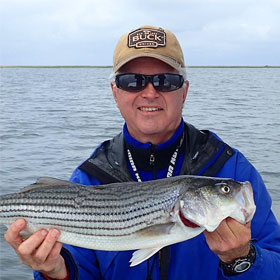Are Salmon Fishing Rigs for Rivers Good for Other Species?
By Ken Schultz
Apr 15, 2020
Salmon fishing rigs for rivers can be adapted to catch catfish, stripers, and walleyes, as well as a number of coastal saltwater species; here’s how and why.
Are salmon fishing rigs for rivers good for catching other species? That query came in from an angler who moved from a northern state to a southern one and wondered if there was any other application for the gear he used for catching river salmon and steelhead, which don’t exist in the warmer waters of southern states.
The answer is a qualified yes, which perhaps is really maybe.
The first thing to know about salmon fishing rigs for rivers is that, for the most part, we’re talking about freshwater fishing rigs used to make deep presentations. Deep doesn’t necessarily mean at a great depth, but it does mean making a presentation on or very close to the bottom – whether that’s in 4 feet of water or 12. That’s because salmon, as well as steelhead, hug the bottom in flowing water, often in long runs or pools. River water flows at varying speeds, so a certain amount of weight is necessary to keep your offering where the fish are as that offering moves with the flow, but not moving much slower or faster than that flow. The heft of that weight varies with depth and current speed.
It's necessary to emphasize this because you have to always bear in mind that you must put your offerings in front of salmon (and steelhead) to have any chance of catching them. In rivers, they do not chase prey, as some other species might. If your offering does not drift right in front of them, moving toward them with the current and at a natural pace, they ignore it.
So, salmon fishing rigs for rivers include a variety of bait-lure-weight arrangements designed for drifting and for fishing while anchored. Trolling is also possible with slightly different rigs, although that generally occurs in significantly deeper water, like at the lower end of rivers and in lakes or coastal waters.
Many of these salmon fishing rigs feature the main fishing line attached to one arm of a three-way swivel, with a short dropper line on one of the swivel arms leading to a weight, and a leader extending from the third swivel arm leading to a lure or to a hook with some type of bait on it. Some of these rigs feature the main line attached to a barrel swivel, with a pencil lead affixed to the other end of the swivel as well as a leader extending to a lightweight fly or hooked bait (such as a salmon egg). Weight styles are designed to facilitate drifting over rocky (snaggy) bottoms and to minimize hangups, provided that an appropriate-size weight is used.
As mentioned, salmon fishing rigs for rivers are freshwater fishing devices. But these are certainly adaptable to coastal rivers and bays where there is tidal flow and the presence of bottom-living species like flounder, drum, spot, croaker, and others, and sometimes roving species like striped bass and bluefish. What changes is the amount of weight used (due to more current and greater depth) to get deep, and the type of bait or lure used (because of local species preference). Driftfishing and anchored-boat fishing with bait situated on or just off the bottom is common in saltwater, so with some modification, salmon rigs are suitable.
In freshwater, some rivers lend themselves to similar presentations when fishing for certain species. Catfish are primarily bottom oriented and are the number one quarry, but landlocked striped bass and walleye are also possibilities. All three of these exist in larger rivers and some impoundments, and freshwater fishing rigs are commonly employed.
Again, the weight size and style may change (depending on depth and whether you’re in a lake or river), as will the bait used, especially for catfish. Here, too, drifting is practiced, usually with current or wind and perhaps aided by an electric motor, as well as anchoring, especially in lakes, making a variation of salmon rigs suitable.









